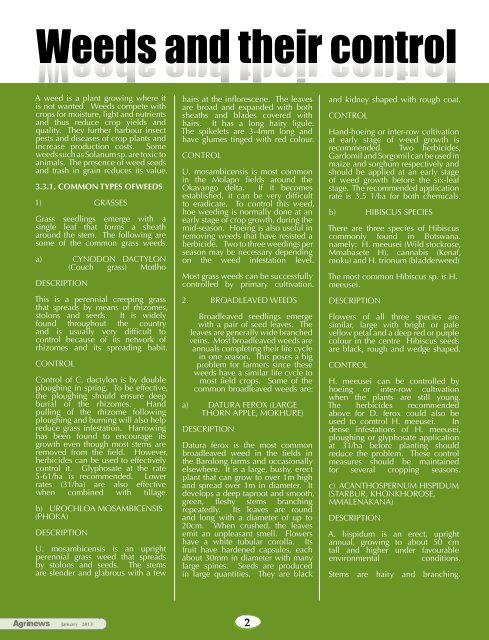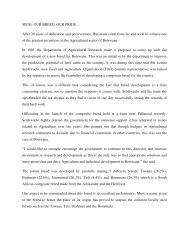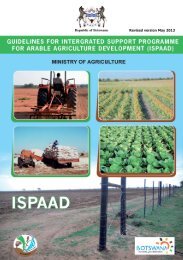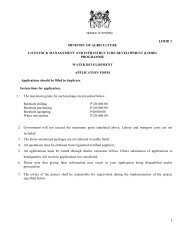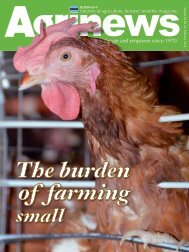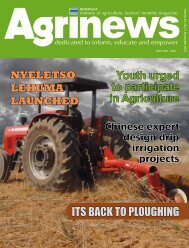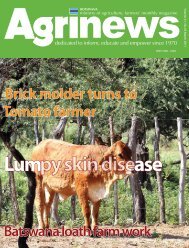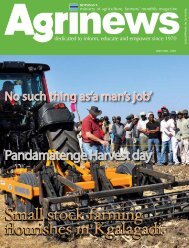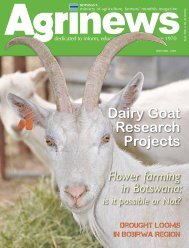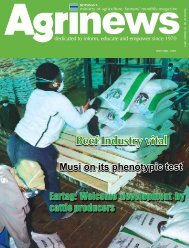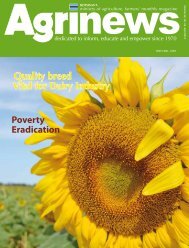Agrinews January 2013 - Ministry of Agriculture
Agrinews January 2013 - Ministry of Agriculture
Agrinews January 2013 - Ministry of Agriculture
Create successful ePaper yourself
Turn your PDF publications into a flip-book with our unique Google optimized e-Paper software.
A weed is a plant growing where it<br />
is not wanted. Weeds compete with<br />
crops for moisture, light and nutrients<br />
and thus reduce crop yields and<br />
quality. They further harbour insect<br />
pests and diseases <strong>of</strong> crop plants and<br />
increase production costs. Some<br />
weeds such as Solanum sp. are toxic to<br />
animals. The presence <strong>of</strong> weed seeds<br />
and trash in grain reduces its value.<br />
3.3.1. COMMON TYPES OFWEEDS<br />
1) GRASSES<br />
Grass seedlings emerge with a<br />
single leaf that forms a sheath<br />
around the stem. The following are<br />
some <strong>of</strong> the common grass weeds.<br />
a) CYNODON DACTYLON<br />
(Couch grass) Motlho<br />
DESCRIPTION<br />
This is a perennial creeping grass<br />
that spreads by means <strong>of</strong> rhizomes,<br />
stolons and seeds. It is widely<br />
found throughout the country<br />
and is usually very difficult to<br />
control because <strong>of</strong> its network <strong>of</strong><br />
rhizomes and its spreading habit.<br />
CONTROL<br />
Control <strong>of</strong> C. dactylon is by double<br />
ploughing in spring. To be effective,<br />
the ploughing should ensure deep<br />
burial <strong>of</strong> the rhizomes. Hand<br />
pulling <strong>of</strong> the rhizome following<br />
ploughing and burning will also help<br />
reduce grass infestation. Harrowing<br />
has been found to encourage its<br />
growth even though most stems are<br />
removed from the field. However,<br />
herbicides can be used to effectively<br />
control it. Glyphosate at the rate<br />
5-61/ha is recommended. Lower<br />
rates (31/ha) are also effective<br />
when combined with tillage.<br />
b) UROCHLOA MOSAMBICENSIS<br />
(PHOKA)<br />
DESCRIPTION<br />
U. mosambicensis is an upright<br />
perennial grass weed that spreads<br />
by stolons and seeds. The stems<br />
are slender and glabrous with a few<br />
Weeds and their control control<br />
their and Weeds<br />
hairs at the inflorescene. The leaves<br />
are broad and expanded with both<br />
sheaths and blades covered with<br />
hairs. It has a long hairy ligule.<br />
The spikelets are 3-4mm long and<br />
have glumes tinged with red colour.<br />
CONTROL<br />
U. mosambicensis is most common<br />
in the Molapo fields around the<br />
Okavango delta. If it becomes<br />
established, it can be very difficult<br />
to eradicate. To control this weed,<br />
hoe weeding is normally done at an<br />
early stage <strong>of</strong> crop growth, during the<br />
mid-season. Hoeing is also useful in<br />
removing weeds that have resisted a<br />
herbicide. Two to three weedings per<br />
season may be necessary depending<br />
on the weed infestation level.<br />
Most grass weeds can be successfully<br />
controlled by primary cultivation.<br />
2. BROADLEAVED WEEDS<br />
Broadleaved seedlings emerge<br />
with a pair <strong>of</strong> seed leaves. The<br />
leaves are generally wide branched<br />
veins. Most broadleaved weeds are<br />
annuals completing their life cycle<br />
in one season. This poses a big<br />
problem for farmers since these<br />
weeds have a similar life cycle to<br />
most field crops. Some <strong>of</strong> the<br />
common broadleaved weeds are:<br />
a) DATURA FEROX (LARGE<br />
THORN APPLE, MOKHURE)<br />
DESCRIPTION<br />
Datura ferox is the most common<br />
broadleaved weed in the fields in<br />
the Barolong farms and occasionally<br />
elsewhere. It is a large, bushy, erect<br />
plant that can grow to over 1m high<br />
and spread over 1m in diameter. It<br />
develops a deep taproot and smooth,<br />
green, fleshy stems branching<br />
repeatedly. Its leaves are round<br />
and long with a diameter <strong>of</strong> up to<br />
20cm. When crushed, the leaves<br />
emit an unpleasant smell. Flowers<br />
have a white tubular corolla. Its<br />
fruit have hardened capsules, each<br />
about 30mm in diameter with many<br />
large spines. Seeds are produced<br />
in large quantities. They are black<br />
and kidney shaped with rough coat.<br />
CONTROL<br />
Hand-hoeing or inter-row cultivation<br />
at early stage <strong>of</strong> weed growth is<br />
recommended. Two herbicides,<br />
Gardomil and Sorgomil can be used in<br />
maize and sorghum respectively and<br />
should be applied at an early stage<br />
<strong>of</strong> weed growth before the six-leaf<br />
stage. The recommended application<br />
rate is 3.5 1/ha for both chemicals.<br />
b) HIBISCUS SPECIES<br />
There are three species <strong>of</strong> Hibiscus<br />
commonly found in Botswana.<br />
namely: H. meeusei (Wild stockrose,<br />
Mmabasete H), cannabis (Kenaf,<br />
moku) and H. trionum (bladderweed)<br />
The most common Hibiscus sp. is H.<br />
meeusei.<br />
DESCRIPTION<br />
Flowers <strong>of</strong> all three species are<br />
similar, large with bright or pale<br />
yellow petal and a deep red or purple<br />
colour in the centre Hibiscus seeds<br />
are black, rough and wedge shaped.<br />
CONTROL<br />
H. meeusei can be controlled by<br />
hoeing or inter-row cultivation<br />
when the plants are still young.<br />
The herbicides recommended<br />
above for D. ferox could also be<br />
used to comtrol H. meeusei. In<br />
dense infestations <strong>of</strong> H. meeusei,<br />
ploughing or glyphosate application<br />
at 31/ha before planting should<br />
reduce the problem. These control<br />
measures should be maintained<br />
for several cropping seasons.<br />
c) ACANTHOSPERNUM HISPIDUM<br />
(STARBUR, KHONKHOROSE,<br />
MMALENAKANA)<br />
DESCRIPTION<br />
A. hispidum is an erect, upright<br />
annual, growing to about 50 cm<br />
tall and higher under favourable<br />
environmental<br />
conditions.<br />
Stems are hairy and branching.<br />
Honey Production<br />
Tapologo’s escape route<br />
Article & photos: France Begensel<br />
Many young women her age<br />
stay home, unemployed<br />
with nothing to do. Some<br />
found solace in Chinese shops while<br />
some roam the streets each day in<br />
search <strong>of</strong> decent jobs. For her, it has<br />
never been easy after completing her<br />
Junior Secondary School education.<br />
Failure to pass the examination meant<br />
she could not further her studies at<br />
senior school level, thus she had to<br />
stay home.<br />
An optimist, Tapologo Moloi has<br />
never given up on anything she<br />
pursued. It was only that insufficient<br />
funds denied her a chance <strong>of</strong><br />
enrolling in private schools to further<br />
her education. She then realised<br />
that she could use her passion for<br />
agriculture to make a living and stop<br />
dependency on her parents.<br />
As a student at Oodima Community<br />
Junior Secondary School, she was<br />
very interested in agriculture related<br />
subjects and she fared well in them.<br />
Moloi is quick to point out that while<br />
at school she was involved in bee<br />
keeping. “Even when I finished my JC<br />
I decided to venture into bee keeping<br />
because I had developed passion for<br />
it and had already gained experience<br />
on caring for bees as a business.”<br />
Prior to starting her bee keeping<br />
project, she attended a three weeks<br />
course in bee farming at the rural<br />
Training center in Sebele. She is<br />
happy the course equiped her with<br />
the necessary training to make it<br />
on her own. She discloses that she<br />
appreciates assistance her village<br />
Agricultural Demonstrator, Boikhutso<br />
Selei provided to her. She is now a<br />
proud holder <strong>of</strong> two certificates in<br />
that field.<br />
Moloi started her production<br />
<strong>of</strong> honey with only one box she<br />
constructed herself. She discloses<br />
that when she reaslised there was a<br />
lot <strong>of</strong> material she could use to make<br />
beehives, she aggressively started<br />
making boxes because it was a lot<br />
cheaper than buying. The 32 year old,<br />
reveals she began with a single box<br />
and currently has five <strong>of</strong> them.<br />
Although all her bees have absconded,<br />
Moloi does not see any reason to just<br />
fold her arms and give up. She is now<br />
working on the place where she will<br />
permanently raise her bees. She has<br />
planted a number <strong>of</strong> trees including<br />
the honey sucker, which she says is<br />
the bee’s favourite, in order to ensure<br />
there will be plenty <strong>of</strong> food for her<br />
bees.<br />
She has ensured that she grows<br />
plants that will be able to withstand<br />
winter so that food will be available<br />
all year round. Plants such as fruit<br />
trees also play an important role in<br />
honey production, the reason she has<br />
planted them too. Moloi decries the<br />
unavailability <strong>of</strong> water in her area <strong>of</strong><br />
production. She is <strong>of</strong> the view that<br />
those like her, when assisted should<br />
be given water tanks to store water.<br />
She says that it is very expensive to<br />
hire people to ferry water from the<br />
village to the fields where her project<br />
is located.<br />
The mother <strong>of</strong> two attributes the<br />
absconding <strong>of</strong> bees to a number <strong>of</strong><br />
challenges including, harrasment by<br />
pests, bee pirate and harsh weather<br />
conditions. She has learnt a lot in the<br />
years she was in production and is<br />
very optimistic that the coming years<br />
will be prosperous for her as she<br />
would also be funded by the Poverty<br />
Eradication Programme to uplift her.<br />
Moloi states that when she began<br />
the project, she did not have any<br />
particular market segment in her<br />
plans. It was only aspiration to keep<br />
bees for their honey. She decided<br />
to sell her first harvest because it<br />
was more than enough for home<br />
consumption. She says she sold in the<br />
village, Modipane and later decided<br />
to sell at open markets in Gaborone.<br />
“I never thought I could make such a<br />
lot <strong>of</strong> money from honey. I have come<br />
to realise that just one box harvest<br />
can give P1500 and this is motivation<br />
enough to grow.” The young lady<br />
reveals that she has extended her<br />
business to making candles, lip<br />
balms, polish and other products<br />
from bee wax. With a broad smile,<br />
she narrates that these products are<br />
also contributing towards her income.<br />
Moloi encourages other youth to<br />
venture into agricultural projects to<br />
pull themselves out <strong>of</strong> the doldrums<br />
<strong>of</strong> poverty, create employment for<br />
themselves and others. Above all, she<br />
says that Batswana should be able to<br />
produce enough to feed themselves<br />
and even export, as called for by<br />
the Vision 2016 and the Millenium<br />
Development Goals.<br />
2<br />
<strong>January</strong> <strong>2013</strong> 3<br />
<strong>January</strong> <strong>2013</strong>


